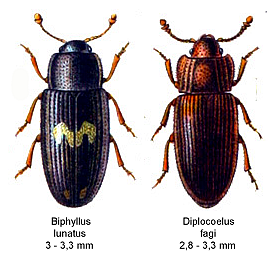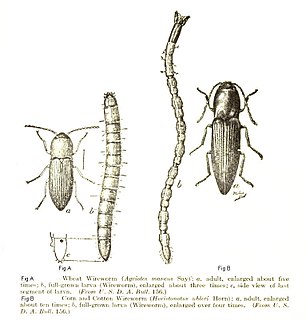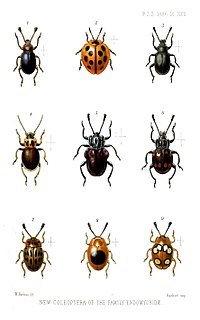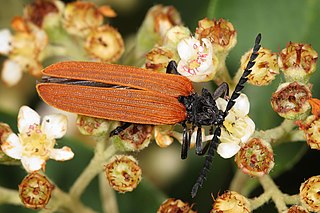 W
WThe Aderidae, sometimes called ant-like leaf beetles, are a family of beetles that bear some resemblance to ants. The family consists of about 1,000 species in about 50 genera, of which most are tropical, although overall distribution is worldwide.
 W
WAlexiidae is a family of beetles, in the suborder Polyphaga, formerly included within the family Cerylonidae. Alexiidae are very small, almost half spherical beetles with clubbed antennae. They are fungivores found in leaf litter or decaying wood. The family contains the single genus Sphaerosoma with the following species:Sphaerosoma algiricum (Reitter, 1889) Sphaerosoma alutaceum (Reitter, 1883) Sphaerosoma antennarium Apfelbeck, 1909 Sphaerosoma apuanum Reitter, 1909 Sphaerosoma bicome Peyerimhoff, 1917 Sphaerosoma bosnicum (Reitter, 1885) Sphaerosoma carniolicum Apfelbeck, 1915 Sphaerosoma carpathicum (Reitter, 1883) Sphaerosoma circassicum (Reitter, 1888) Sphaerosoma clamboides (Reitter, 1888) Sphaerosoma compressum (Reitter, 1901) Sphaerosoma corcyreum (Reitter, 1883) Sphaerosoma csikii Apfelbeck, 1915 Sphaerosoma diversepunctatum Roubal, 1932 Sphaerosoma fiorii Ganglbauer, 1899 Sphaerosoma globosum (Sturm, 1807) Sphaerosoma hemisphaericum Ganglbauer, 1899 Sphaerosoma hispanicum Obenberger, 1917 Sphaerosoma laevicolle (Reitter, 1883) Sphaerosoma latitarse Apfelbeck, 1915 Sphaerosoma lederi (Reitter, 1888) Sphaerosoma leonhardi Apfelbeck, 1915 Sphaerosoma libani Sahlberg, 1913 Sphaerosoma maritimum (Reitter, 1904) Sphaerosoma merditanum Apfelbeck, 1915 Sphaerosoma meridionale (Reitter, 1883) Sphaerosoma nevadense (Reitter, 1883) Sphaerosoma normandi Peyerimhoff, 1917 Sphaerosoma obscuricorne Obenberger, 1917 Sphaerosoma obsoletum (Reitter, 1883) Sphaerosoma paganetti Obenberger, 1913 Sphaerosoma rotundatum Obenberger, 1913 Sphaerosoma pilosellum (Reitter, 1877) Sphaerosoma pilosissimum (Frivaldszky, 1881) Sphaerosoma pilosum (Panzer, 1793) Sphaerosoma pubescens (Frivaldszky, 1881) Sphaerosoma punctatum (Reitter, 1878) Sphaerosoma puncticolle (Reitter, 1883) Sphaerosoma purkynei Obenberger, 1917 Sphaerosoma quercus Samouelle, 1819 Sphaerosoma rambouseki Apfelbeck, 1916 Sphaerosoma reitteri (Ormay, 1888) Sphaerosoma scymnoides (Reitter, 1885) Sphaerosoma seidlitzi (Reitter, 1889) Sphaerosoma shardaghense Apfelbeck, 1915 Sphaerosoma solarii Reitter, 1904 Sphaerosoma sparsum Reitter, 1909 Sphaerosoma sturanyi Apfelbeck, 1909 Sphaerosoma subglabrum Peyerimhoff, 1917 Sphaerosoma sublaeve (Reitter, 1883) Sphaerosoma tengitinum Peyerimhoff, 1917 Sphaerosoma vallambrosae (Reitter, 1885) Sphaerosoma winneguthi Apfelbeck, 1915
 W
WAnamorphidae is a family of beetles in the order Coleoptera, formerly included within the family Endomychidae. There are about 10 genera and at least 20 described species in Anamorphidae.
 W
WBiphyllidae, or false skin beetles, are a family of beetles, in the suborder Polyphaga. Worldwide, about 195 species are known. They live under the bark of dead trees and feed on fungi. It contains the following genera:Althaesia Pascoe, 1860 Anchorius Casey, 1900 Anobocaelus Sharp, 1902 Biphyllus Dejean, 1821 Diplocoelus Guérin-Méneville, 1836 Euderopus Sharp, 1900 Gonicoelus Sharp, 1900 †Paleobiphyllus Makarov and Perkovsky 2019 Taimyr amber, Russia, Santonian
 W
WBothrideridae is a family of beetles in the suborder Polyphaga. They are known commonly as the cocoon-forming beetles or dry bark beetles. They occur worldwide with most native to the Old World tropics.
 W
WBuprestidae is a family of beetles known as jewel beetles or metallic wood-boring beetles because of their glossy iridescent colors. Larvae of this family are known as flatheaded borers. The family is among the largest of the beetles, with some 15,500 species known in 775 genera. In addition, almost 100 fossil species have been described.
 W
WByrrhidae, the pill beetles, is a family of beetles in the superfamily Byrrhoidea. These beetles are common in the forests of the Northern Hemisphere. They feed mainly on moss. Populations increase after wildfires. The oldest undoubted record of the family is Lidryops from the earliest Late Cretaceous Charentese amber of France, with other less certain records going back to the Middle Jurassic, but these possibly belong to Byrrhoidea.
 W
WByturidae, also known as Fruitworms, is a very small family of beetles, in the suborder Polyphaga, comprising fewer than 20 species worldwide. The larvae of some species develop in fruits. Byturus unicolor affects species of Rubus and Geum.
 W
WCallirhipidae is a family of cedar beetles in the order Coleoptera. There are ten genera in Callirhipidae.
 W
WCerylonidae are small to tiny, smooth, shiny, hairless beetles, only lightly punctured. There are about 450 species worldwide in 50 or so genera, mostly tropical and subtropical. They are most common under the bark of dead trees, but can also occur in compost and other decaying plant material. Little is known specifically about their biology but they are thought to be either predators that feed on other small animals or fungus eating.
 W
WCorylophidae is a family of minute hooded beetles, sometimes called minute fungus beetles, in the order Coleoptera. There are about 18 genera and at least 120 described species in Corylophidae.
 W
WElateridae or click beetles are family of beetles. Other names include elaters, snapping beetles, spring beetles or skipjacks. This family was defined by William Elford Leach (1790–1836) in 1815. They are a cosmopolitan beetle family characterized by the unusual click mechanism they possess. There are a few other families of Elateroidea in which a few members have the same mechanism, but most elaterid subfamilies can click. A spine on the prosternum can be snapped into a corresponding notch on the mesosternum, producing a violent "click" that can bounce the beetle into the air. Clicking is mainly used to avoid predation, although it is also useful when the beetle is on its back and needs to right itself. There are about 9300 known species worldwide, and 965 valid species in North America.
 W
WElmidae, commonly known as riffle beetles, is a family of beetles in the superfamily Byrrhoidea described by John Curtis in 1830. Both adults and larvae are usually aquatic, living under rocks in fast-flowing shallow areas of streams, such as riffles, feeding on algae and biofilms. There are more than 150 genera and 1,500 described species in Elmidae. The oldest record of the group is Cretohypsilara from the Cenomanian aged Burmese amber.
 W
WEndomychidae, or handsome fungus beetles, is a family of beetles with representatives found in all biogeographic realms. There are around 120 genera and 1300 species. The family was established based on the type genus Endomychus, a genus erected in 1795 by Panzer which was applied to a species that Linnaeus called Chrysomela coccinea. As the common name suggests, Endomychidae feed on fungi. Crowson, in his influential treatment of the beetles, placed the family within the Cucujoidea. They have a tarsal formal of 4-4-4 or 3-3-3 and the wings lack a closed radial cell. The second antennal segment has a sensory appendage that is as long as the third antennal segment. The family has also been grouped with the Coccinellidae in a group called the Trimera for having pseudotrimerous tarsi. A 2015 molecular phylogeny study found that the Cucujoidea were found to be non-monophyletic and the Endomychidae was refined with the removal of the Anamorphinae from within the family and elevated to the status of a full family, Anamorphidae. Mycetaeinae and Eupsilobiinae were also found not to belong within the clades of the core Endomychidae, and likewise reclassified into the families Mycetaeidae and Eupsilobiidae.
 W
WGeorissus, also called minute mud-loving beetles, is the only genus in the beetle family Georissidae. They are tiny insects living in wet soil, often near water. Found on every continent except Antarctica.
 W
WLatridiidae is a family of tiny, little-known beetles commonly called minute brown scavenger beetles or fungus beetle. The number of described species currently stands at around 1050 in 29 genera but the number of species is undoubtedly much higher than this and increases each time a new estimate is made.
 W
WThe longhorn beetles (Cerambycidae), also known as long-horned or longicorns, are a large family of beetles, with over 35,000 species described, slightly more than half from the Eastern Hemisphere. Most species are characterized by extremely long antennae, which are often as long as or longer than the beetle's body. In various members of the family, however, the antennae are quite short and such species can be difficult to distinguish from related beetle families such as the Chrysomelidae. The scientific name of this beetle family goes back to a figure from Greek mythology: after an argument with nymphs, the shepherd Cerambus was transformed into a large beetle with horns.
 W
WThe Lycidae are a family in the beetle order Coleoptera, members of which are commonly called net-winged beetles. These beetles are cosmopolitan, being found in Nearctic, Palearctic, Neotropical, Afrotropical, Oriental, and Australian ecoregions.
 W
WThe Mordellidae are a family of beetles commonly known as tumbling flower beetles for the typical irregular movements they make when escaping predators, or as pintail beetles due to their abdominal tip which aids them in performing these tumbling movements. Worldwide, there are about 1500 species.
 W
WMurmidiidae is a family of beetles in the order Coleoptera, formerly included within the family Cerylonidae. There are at least three genera and about five described species in Murmidiidae.
 W
WMycetaeidae is a family of beetles in the order Coleoptera, formerly included within the family Endomychidae. There is at least one genus, Mycetaea, and at least one described species in Mycetaeidae, M. subterranea.
 W
WThe family Oedemeridae is a cosmopolitan group of beetles commonly known as false blister beetles, though some recent authors have coined the name pollen-feeding beetles. There are some 100 genera and 1,500 species in the family, mostly associated with rotting wood as larvae, though adults are quite common on flowers. The family was erected by Pierre André Latreille in 1810.
 W
WFire-coloured beetles are the beetles of the Pyrochroidae family. Adults measure 4-20 mm; larvae reach 25 mm. Larvae of Pyrochroinae are found under moist bark of dead trees. They are probably mostly fungivorous, although they may become cannibalistic if too crowded.
 W
WScirtidae is a family of beetles (Coleoptera). These beetles are commonly referred to as marsh beetles, as the larvae are typically associated with stagnant water, but can be found in flowing water. Adults prefer decomposing plant material near the water's edge. More than an estimated 600 species are known worldwide, distributed among at least 60 genera.